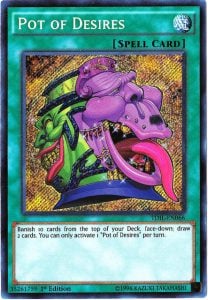A Note on Notation
It's important to understand the notation behind the mathematics. If you look at the Hypergeometric Calculator, you'll notice there there are actually five different output boxes. In the first article, we just ignored most of these. However, you should learn the uses of the other four as well, and what they mean:
Notation: P(X)
P(X) essentially means "The probability of X happening". You can rewrite it as anything you like:
- P(Y) is "The probability of Y happening".
- P(Stratos coming off of the next banlist) can be read as "The probability of Stratos coming off of the next banlist".
We usually use this P(X) with an equals sign. For example: P(X) = 1 means "The probability of X happening is 100%". Remember that probabilities are usually written as decimals. To turn a decimal into a percentage, just multiply it by 100.
Probability of exact odds: P(X = 1)
Let's get into the outputs on the calculator. The very first is P(X = 1). This, as you might have guessed, is "The probability of X being exactly equal to 1".

Note that, in this scenario, X is the card that we're looking to draw. If you're using working out the probability of having a Terraforming in your opening hand, "X" stands for "Terraforming". P(X = 1) tells us how likely we are to draw into exactly 1 copy of the card we're looking for - In this instance, Terraforming!
This is different to the probability we worked out in the previous article. Before, we were only looking at the last box. "P(X ≥ 1)" told us the chance that we draw 1 or more copies of X. In comparison, "P(X = 1)" tells us the chance that we draw exactly 1 copy of X: No more, no less.
Probability of odds (less than): P(X < 1)
If you're not familiar with the "<" and ">" symbols, they mean "is less than" and "is greater than" respectively. "P(X < 1)" translates to "The probability of X being less than 1".
Since we're not physically able to draw half of a card, this essentially means "The probability of X being less than 1". Or in other words, "The probability that we don't draw X at all". This can be useful for working out when we don't want to draw a card in our opening hand - For example, Gem-Knight Garnet.
Probability of odds (Less than or equal to): P(X ≤ 1)
This one is very similar to the last one. Note the subtle difference of the equals sign. "P(X ≤ 1)" means "The probability of X being less than or equal to 1".
Essentially, this box tells us the liklihood of us opening exactly one copy of a card or no copies of that card at all. It may not seem useful at first, but can come in useful when you're playing a deck with lots of 3-card playsets.
Probability of odds (Greater than): P(X > 1)
You should be getting the hand of this by now. "P(X > 1)" means "The probability of X being greater than 1".
It's the chance of us drawing into more than one copy of X. Again, this can come in useful when you're playing a deck which utilizes multiple copies of the same card. Want to work out the chance of you drawing into that second Gem-Knight Garnet? P(X >1) can help you.
Probability of odds (Greater than or equal to): P(X ≥ 1)
"P(X ≥ 1)" means "The probability of X being greater than or equal to 1".
Finally! This is the one we used in the first article, and is the most commonly used output. Although all of these probabilities may seem extremely similar, they each have very specific uses in deckbuilding.
Applying the Maths

To start off, let's recap P(X ≥ 2), which is the output we used in the first article. Here's a common scenario in which this is relevant:
You're playing a "Burning Abyss" deck. It's really important that you have at least 2 "Burning Abyss" monsters in your opening hand, so that you can summon Dante, Traveler of the Burning Abyss on the first turn. Given that you play 18 "Burning Abyss" Monsters in a 40-card deck, what's the probability of seeing at least 2 "Burning Abyss" monsters in a 5-card opening hand?
Firstly, let's type all of that information into out Hypergeometric Calculator:
- Population Size = 40
- Number of Successes in Population = 18
- Sample Size = 5
- Number of Successes in Sample: 2
At this point, you might notice that the output boxes have changed a little! All of the P(X ≥ 1) notation on the calculator has changed to P(X ≥ 2). This is because we're calculating the probability of 2 successes in sample, rather than just 1.
Anyway, the calculator says that P(X ≥ 2) = 76%. Looks like the deck is pretty consistent!
Calculating exact probability
 As previously mentioned, it's important to open at least 2 BA monsters. However, any hand containing more than 2 BA monsters can sometimes be seen as sub-optimal: We often want to have the rest of our hand be Trap cards.
As previously mentioned, it's important to open at least 2 BA monsters. However, any hand containing more than 2 BA monsters can sometimes be seen as sub-optimal: We often want to have the rest of our hand be Trap cards. We just worked out that this particular deck can Summon Dante on the first turn around 76% of the time. However, how often will we have an optimal hand of exactly 2 BA monsters?
This is where the other forms of P(X) come into use! Let's work out the probability that our opening hand contains exactly 2 BA monsters. We already have the calculator set up, so we just need to find the correct output. P(X = 2) will tell us the probability of seeing exactly two BA monsters: In this case, P(X = 2) = 36%. Easy!
Banishing cards with Pot of Desires
 Pot of Desires has been a pretty controversial history associated with it. The downside of playing it is mainly seen in how it can banish every last copy of a card from your deck! Using the hypergeometric calculator, we can work out how likely this is to happen.
Pot of Desires has been a pretty controversial history associated with it. The downside of playing it is mainly seen in how it can banish every last copy of a card from your deck! Using the hypergeometric calculator, we can work out how likely this is to happen.For this example, we're going to use a population size of 35. This is because you've already drawn 5 cards from your deck at the start of the game. You might have already drawn or searched a copy of a card you'd otherwise banish! We'll work out the odds of banishing a card which we play 3 copies of first. Because of this, the Number of Successes in Population here is 3. Sample Size is 10 here, since Desires banishes 10 cards. Finally, the Number of Successes in Sample is also 3. This is because we're checking to see if all 3 copies are in those banished 10 cards.
- Population Size = 35
- Number of Successes in Population = 3
- Sample Size = 10
- Number of Successes in Sample: 3
The output we're looking for here is P(X = 3), because we want to see the chance that we banish all 3 copies of a card. That comes to 2%. This means that you'll only banish all 3 copies of a given card with Pot of Desires once every 50 games!
Other Uses
You can also use this to work out a plethora of other things. To work out the probability of banishing a card which you play only 1 copy of, change the Number of Successes in Population and Number of Successes in Sample to 1. To work out the probability of banishing more than 1 copy of a card, find P(X > 1). How about working out how likely you are to banish a card in a deck featuring more than 40 cards!
Recap

This article was much more notation-based than the previous one, which may seem unimportant right now. However, learning the symbols and terminology is essential for what's to come. It's vital to learn the ins and outs of notation, in order to tackle more complex problems! In this article, we covered:
- P(X = N), The probability of drawing exactly N copies of cards
- P(X < N), The probability of drawing less than N copies of cards
- P(X ≤ N), The probability of drawing less than or exactly N copies of cards
- P(X > N), The probability of drawing more than N copies of cards
- P(X ≥ N), The probability of drawing more than or exactly N copies of cards
- How to work out the optimal number of "Burning Abyss" monsters to run in a deck
- How likely it is to banish all copies of a card from a deck with Pot of Desires
Until next time - Stay Groovy!




